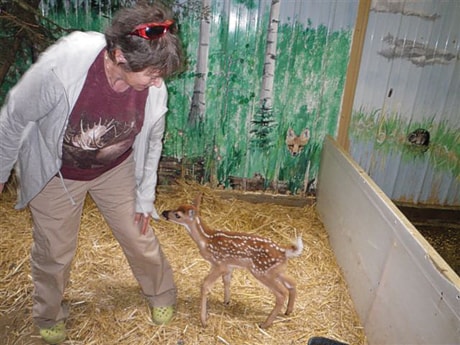Boom times at the Medicine River Wildlife Centre can cause problems for a charitable, not-for-profit organization that is compassionately dedicated and determined not to turn any “business” away.
Since 1984, the principal activity of MRWC has been operating a hospital and environmental education centre for the treatment and rehabilitation of injured wildlife and facilities for the fostering of wildlife orphans, and eventually returning most of the patients and inmates to their natural environments. To achieve that mandate, the staff and volunteers are on duty 24/7, 365 days a year to collect and admit patients and orphans.
This is a particularly busy time of year in the songbird section, where abandoned nestlings of various species are reared. For some reason this year, fewer abandoned deer and moose young than usual are in the Centre. I suspect that the dreary, wet spring and early summer has played a part, in that not nearly as many people as usual are out and about in the outdoors and finding fawns and calves that are apparently abandoned.
On yet another grey, rainy weekend day recently, I crossed several high and muddy rivers and arrived at the Centre for the first time in too many years. Immediately I was struck by the new sign at the parking lot, featuring a sculpted caricature of Otis the Owl, the now seven-year-old great horned owl mascot of the Centre, with a bandage on his left wing. Otis cannot fly well enough to survive the wilds, but he toils away at helping to promote the Centre.
Some other healed species that cannot be released back to the wild perform priceless service mothering and mentoring successive broods of orphans.
At the other end of the parking lot is another new sign marking the head of the nature-hiking trail over the expanded area of the centre through recent land acquisitions, both saving native forest and marshland: one piece from being trashed by a commercial ATV playground, the other from becoming a private trap and skeet range. Both uses were deemed by the Centre’s board to be incompatible with the treatment and rehabilitation of wildlife.
The extra nearby varied micro-habitats are useful to the Centre, both for returning former patients and inmates to their natural environments, and for its expanding educational programs focused on public understanding of the outdoors and the hazards to wildlife in a sometimes uncaring world.
There are many educational exhibits inside the main building, a principal one dealing with wildlife hazards. From her many years of experience treating injured wildlife, Carol Kelly, Centre founder, and executive director, lists the main causes of injuries to wildlife as vehicles, barbed wire, electricity, windows, and domestic and feral cats. In a glassed enclosure in the main lobby area, a wild creature called Charlie was busy being a porcupine, eating and snoozing; he is named for the RCMP officer who delivered him by caesarian section after accidentally hitting Charlie’s mother on
the highway.
There is always need for repairs and maintenance, and the land acquisition is especially expensive. Carol Kelly sighs and says that, somehow, they always eke it out, but nothing is left over at the end of the year for the plans she, staff, volunteers, and the board have for expansion of the care and treatment facilities and for the expanding public education programs. They are currently brainstorming for ideas to expand the funding.
The Centre does benefit from some grants, but, in my opinion, not nearly what they should for the good it does.
Otherwise, along with the care of the wildlife and the education of the public, it takes constant hustling for the Centre to raise just operating revenues, let alone expansion money. Major sources of funds are private and corporate donations, casinos, and annual sales of the Centre’s calendar and items sold in the gift shop.
To get an idea of how the Centre makes the most of anything it can: it sells sanitized owl pellets to schools and students for $1 a pop for study of the small bones, fur, feathers, etc. they contain.
The Centre welcomes many visitors annually from May 1 to Labour Day, seven days a week from 10 am to 5 pm. From Labour Day to April 1st, visits are by appointment only (call 403-728-3467). To reach the Centre, you travel Hwy 54 to Raven, and then follow the signs, four kms. south on Range Road 42 to Twp. Rd. 360, then 1.5 kms. east to the Centre’s new Otis sign.
Failing a personal visit, the Centre can be virtually visited on its website
(www.mrwc.ca), which is, like all else around the actual site, constantly being expanded and improved.
However you do it, drop in and be amazed, as most visitors are, by the enthusiasm, dedication, compassion and just plain energy of everyone involved with the Centre.
Bob Scammell is an award-winning outdoors writer living in Red Deer.
